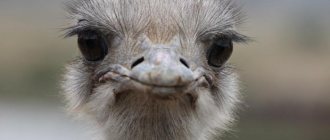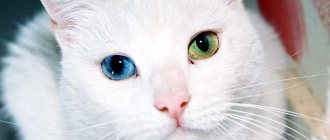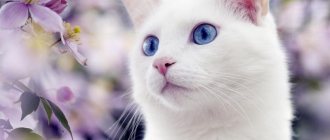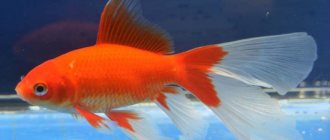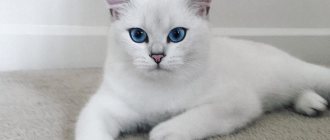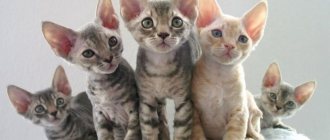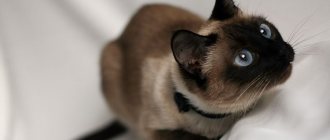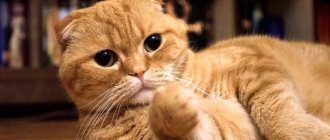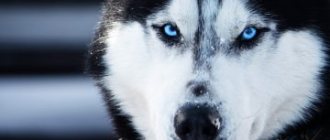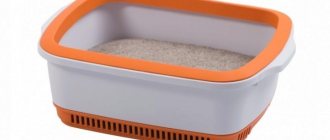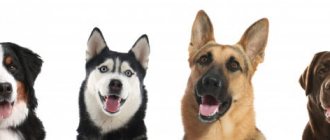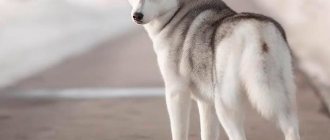Exotic Shorthair
A young breed of cat with a wide, flattened muzzle, on which incredibly large eyes of green, blue or amber stand out. They have a fairly large body and soft, thick fur of different shades. These are cats with an easy-going character that fit well into the family and love active games.
Breeds not included in the top ten most famous
Some of the cutest cats with big eyes come from random mutations and selection. An expressive look can be found in many representatives of the cat breed, but few have truly huge eyes.
Cats with different eyes - examples of what breeds are called
One of the most popular cats, not included in the top ten famous ones, is Cobby the British shorthaired chinchilla. All representatives of this variety have a bluish-gray coat color, and Cobby has a snow-white coat, perfectly combined with huge sky-blue eyes. They are incredibly expressive thanks to the black edging.
The next representative, often compared to the Cheshire cat, is Gimo. This is a cute cat with huge golden eyes.
Snoopy the cat is a short-haired exotic cat with huge eyes. He has an innocent, wise look, which contains natural charm.
Note! Due to the huge visual organ, these animals have a visual angle of 170-185 degrees. For representatives of the cat breed with normal eyes, this angle is 160-169 degrees.
Snoopy the Cat
Scottish Fold cat (Scottish Fold)
Miniature forward-curved ears and large round eyes with a surprised expression give these cats a touching and touching appearance. They have a calm, balanced character and are even trainable; they especially like to stand on their hind legs. But they will never forget to remind you with their voice that they forgot to feed or caress them.
Top 10 big-eyed breeds or the most “soulful” cats
Remember the cartoon about Snoopy? This character is beloved by both children and adults. A velvety prankster with huge sweet eyes who loves hugs. The prototype of the multi-hero was a cat of a real existing breed - exotic shorthair. Although the huge bottomless eyes of “Snoopy” are not considered the largest in the world. Perhaps because the animals themselves are small.
So who then are these mysterious creatures with a wide soul? After all, according to a popular expression, the soul should be wider, the larger the size of the eyes? Here are eight of the biggest big-eyed four-legged creatures known to man.
Ukrainian Levkoy
The first association when seeing a representative of this young breed is the fold-eared Sphynx. Pets have a muzzle with clearly defined cheekbones, high, forward-curled ears and a slender, graceful body. Really huge eyes are filled with sadness and sadness. They often have a green, less often blue tint, and are shaped like human ones. Levkoys are distinguished by their affectionate nature and are always devoted to their owner.
Lynx-like felines that can live with humans
Lynxes are not the only representatives of the family with long hairs on their ears and camouflage coat color. Among wild relatives, caracals and jungle cats have the greatest external resemblance to the famous predator. They also live in the wild, but can live with humans. However, for their maintenance it is necessary to create conditions close to the natural environment.
Caracal - steppe lynx
The caracal is called the steppe lynx. Wild caracals are found in Africa, Central Asia, the Middle East, and in some areas of Turkmenistan, Kyrgyzstan, Uzbekistan and Dagestan.
Caracal
Caracals have a slimmer build and weigh 11–12 kg. The tall, straight ears have distinct, long dark hairs. The steppe lynx's fur is dense, short, and has hard bristles on its paws. A distinctive feature of the caracal is its reddish coat without spots. In addition, the animal has a fairly long tail, growing up to 30 cm.
Baby caracals
Kittens born in the wild will not be able to become pets. Only animals born from individuals kept in captivity can live with humans. It is better to keep domesticated caracals on the territory of country houses, where they will have the opportunity to move freely over a large area.
When keeping a caracal at home, special attention should be paid to nutrition. A predator's diet must include raw meat, poultry, and eggs.
Some owners of these exotic pets feed them premium or super-premium dry ready-made food.
It is not recommended to have caracals in a house where there are small children.
A predator has very strong natural instincts, so if handled carelessly, it can quickly hit back at the offender.
Jungle cat - marsh lynx
People were able to tame the jungle cat 3 thousand years ago. The people of Egypt were the first to do this. They called it house, which meant "house", because the animals lived in people's houses. Another nickname for the animal is the swamp lynx. These animals do not like to go out into open areas. They live in reed thickets, among bushes growing on the banks of water bodies, and often hunt for fish and waterfowl. Animals visit human settlements only when there is a lack of food. They raid chicken coops.
jungle cat
Populations of these predators are mainly found in regions with warm climates. They live in Africa, Central Asia, the Caucasus, and also live in India, Palestine, and Thailand. In Russia, animals can be seen on the Volga coast and in Dagestan.
This predator is similar to a lynx in the color of its coat, but is smaller in size. The body length of the jungle cat is about 90 cm, the weight of the largest individuals reaches 12 kg, the height at the withers does not exceed 0.5 m. Small spots on the body are almost invisible in adult individuals, they are more pronounced in kittens.
The jungle cat becomes a pet only in exceptional cases. Developed natural instincts make it dangerous even for the owner who has lived nearby since childhood.
You can keep a swamp lynx in an area where it can freely hunt, swim and walk. The proximity of other pets to a wild cat is unacceptable.
Singapore
A rare breed of cats from Asia, the representatives of which look like small lions. Rounded ears and round eyes of amber or muted green add expressiveness to their appearance. A distinctive feature is the almond-shaped eyes, which is rarely found in large-eyed breeds. Cats have a gentle voice and a cheerful disposition; they love to move and play a lot.
No. 2. Scots charm
Scottish Fold cats or Scottish Fold are one continuous bundle of fluffy childish spontaneity and touchingness. And all thanks to the large round eyes, filled with naive surprise. Add here miniature ears folded in a couple of rows and that’s it, you want to squeeze this creature and be touched endlessly.
The entire color scheme of the iris depends on the shade of the coat. Different subspecies of Scots have their own. Let’s say that harlequins will have beautiful tea-colored eyes, and black lop-eared ones will delight you with orange lakes. Consider this nuance when choosing a breed. And watch the animal’s diet, food is their weakness, and obesity is a common disease.
By the way, there is one important feature when breeding Scottish Folds. It is strictly forbidden to cross two fold-eared Scots. This can lead to severe genetic mutations, such as rigid tail syndrome or serious problems with the spine and joints. What to do, you ask?
Some cat litters occasionally produce kittens with straight ears. They are called straights and they are used for mating animals. So if such a creature appears in your family, do not be upset - this is not a culling, but a very valuable shot that can bring the owner not only pleasure from communication, but also good money.
Devon Rex
Cats with a triangular narrow muzzle, huge ears and equally large eyes, the expression of which can change from proud and offended to dreamy. They have a flexible, thin body that is covered with short curly hair. These animals have a developed hunting instinct and are highly amenable to learning commands (for example, sit, lie down, stand on their hind legs).
In the gallery we have collected several photos of beautiful pets with big eyes:
It is worth noting that among cats there are some hybrids of other breeds, which as a result get large eyes. But any pet, regardless of the size of its eyes, needs the affection and care of its owner.
Features of caring for cats with large eyes
Whatever breed your big-eyed pet is, you need to take care in advance about the conditions in which it will end up. To make your cat comfortable in your home, you will need the following things:
- a bed, a house or a play complex (you need to select it according to the size of an adult cat of the selected breed);
- scratching post and nail clipper (the scratching post can come complete with the house, or be separate, in the form of a small toy);
- ceramic or metal bowls (2 pieces for food, 1 for water);
- first aid kit (iodine, brilliant green, tourniquet, bandage, cotton wool, business card of the nearest veterinary clinic, etc.);
- clothes for the cat (if the pet is hairless);
- combs (combs, brushes, slickers, furminators - depending on the length of the coat);
- shampoos and conditioners for bathing (cats need to be bathed approximately once every six months or more often if they are dirty);
- cotton swabs for cleaning ears (the procedure is carried out 1-2 times a week, for fold-eared cats - every day);
- cotton pads for wiping eyes (every day);
- harness and leash for walking (it is convenient to choose harnesses with an adjustable size);
- carrying bag for trips and trips.
Features of fur coat care for each individual cat are determined by the nuances of the breed, the length of the coat and the character of the pet. For example, hairless cats are not combed, but wiped with a damp cloth. This procedure can be carried out every day. Hairless cats (like the Ukrainian Levkoy) sweat more than their furry counterparts, causing sweat and dirt to accumulate on the animal's skin. It is important to dress the cat in warm cat clothes immediately after the procedure (hairless cats can catch a cold).
Short-haired cats are brushed once a week (with a comb or brush). You can bathe them once every six months. But long-haired pets require more complex procedures. The longer the coat and the thicker the undercoat, the more time you will have to spend on combing. This must be done daily, otherwise tangles may form (and unraveling them is painful). But you can bathe fluffy, big-eyed cats up to 4-5 times a year.
A long-haired cat may not like the slicker, because sometimes the curved teeth of the slicker can pull out healthy hair. Of course, there are cats that love to be brushed, for example, my grandmother's former cat loved her slicker, waiting for the procedure to be repeated every evening. I heard that it depends on the nature of the animal. For example, Persian cats are lazy, so they don’t care what their owner does to them.
Video: how to comb a cat
Eye care
Every owner of a big-eyed cat should know how their pet's eyes work: there is a small amount of liquid between the eyeball and the mucous membrane. It is needed to make it easier for the eyelid to glide. In addition, the fluid is constantly renewed, and the old one comes out in the form of mucus along with dirt that gets on the membrane of the eye. The inner corner of the cat's eye is directed downwards, and is continued by an almost imperceptible path (a line that can stretch along the length of the nose). Excess liquid should flow out along this path. In the morning, discharge may accumulate in the corner of the eye, forming a crust.
Often cats can remove this dirt themselves when washing themselves, but humans must monitor the cleanliness of their eyes. Some snub-nosed cats (for example, Persians) have a special structure of the nasal septum. Because of this, discharge from the eyes may be profuse. You shouldn’t be afraid of this; this feature is considered the norm for such breeds.
To avoid any problems with your pet’s eyes, you need to examine the animal every morning. You need to wash and remove dirt not only from the very corner of the eye, but also from the fur around it. A small part of the discharge with dirt may remain here; if it gets back into the eye, inflammation may begin. To wipe a cat's eyes, you need cotton pads and distilled water.
Pet pharmacies sell a special gel or lotion that is convenient for treating the eyes of adult cats.
Some owners of mustachioed pets use tea to moisten cotton wool. A strong infusion of tea is very beneficial for the eyes, but the dark liquid can stain the fur of a light-colored animal. This is important to consider if your pet is going to have any kind of show (for example, an exhibition).
To wipe the eyes of light-colored cats, you need to use a clear liquid.
You can determine if your pet has problems with his eyes using the following criteria:
- discharge;
- lacrimation;
- red or white inner eyelid;
- hard crusts (scabs) in the corners of the eyes;
- fur on the face with traces of tears;
- closed eye (or both);
- clouding of the eye or change in its color;
- visible third eyelid;
- changes in behavior.
Gestures and facial expressions of cats can also warn of a possible illness. If a cat's eyes hurt, it may squint or scratch its face with its paws. If you notice any of the above symptoms, you should contact your veterinarian. Some cat owners try to cure their pets themselves using medications intended for humans, but this is strictly forbidden. Only a veterinarian can determine the disease and prescribe the correct treatment.
When my friends' cat got sick, they made a mistake - they started self-medicating. The cat's eyes were watering, and the owners tried to treat her with antibiotics and some other pills, having read about a rare disease that people usually bring from resorts. Treatment didn't help and they had to see a veterinarian. It turned out that the cat had conjunctivitis. The veterinarian prescribed an ointment, and the animal was cured. But in total, the cat suffered for almost 2 months. If the owners had immediately gone to the veterinary clinic, this torment could have been stopped much earlier.
If a cat has eye problems, you should not self-medicate.
There are many diseases related to the eyes. The most common ailments are:
- Conjunctivitis: Your cat's eyes appear red and swollen, and there may be some discharge. Caused by injuries, foreign bodies, chemicals entering the eye, as well as infectious diseases.
- Protrusion of the third eyelid: If the third eyelid becomes visible and covers your pet's eye, he may be injured, suffering from diarrhea, viruses or worms.
- Keratitis (inflammation of the cornea of the eye): if the cornea of the eye is inflamed, it becomes cloudy and watery.
- A cataract is a clouding of the lens, causing it to become smoky or white. This is often seen in older cats, as well as those with diabetes.
- Glaucoma: The cornea becomes cloudy and the eye becomes enlarged due to increased pressure in the eyeball. If you do not immediately contact a veterinary clinic to reduce intraocular pressure, the cat will go blind.
- Bulging eye(s): Bulging of the eye can occur due to injury or swelling.
- Retinal diseases: associated with the degeneration (degeneration) of light-sensitive cells in the back of the eye, can lead to partial or complete loss of vision.
- Tearing: Hair around a cat's eyes that shows signs of tears indicates a blocked tear duct or overproduction of tears.
The veterinarian makes a diagnosis and prescribes treatment. Doctors usually prescribe medications that are sold in pet pharmacies:
- Lacrimin;
- Lacrican;
- Levomycetin (0.25%);
- Hydrocortisone or tetracycline eye ointment;
- Iris;
- Tsiprovet;
- Anandin.
The best prevention of cat eye diseases is regular preventative examinations with a veterinarian, timely vaccinations and proper care.
Feeding cats with big eyes
Breeders recognize three types of feeding: ready-made food, natural food and mixed food. With any option, it is important to consider that the diet must be balanced . Industrial feeds are already formulated in such a way that they contain proteins, fats, carbohydrates and vitamins in the correct proportions. But with natural feeding, responsibility for the balance of microelements rests only with the owner. The cat should receive various vitamins necessary for proper bone growth, healthy fur, good vision, etc.
Sometimes you can read a request for a treat in a cat’s big eyes, but you shouldn’t give in - the cat must have a complete diet rich in vitamins and no harmful substances
Owners who believe that their cat needs vitamins buy or plant special grass. Animals enjoy eating green sprouts. This grass is safe, you can’t overeat it, and cats don’t get better from it. But it contains a lot of vitamins and fiber, which, among other things, has a beneficial effect on the pet’s gastrointestinal tract.
Cats need almost all the same vitamins as humans. Breeders attach particular importance to the following:
- Vitamin B2. Due to the lack of this vitamin, weight loss occurs, baldness occurs on the spine, near the eyes and around the ears. The owner will notice cloudy eyes and weakness of the animal. Kittens experience slower growth.
- Vitamin B12 improves liver function and nervous system. Without it, the cat is inactive, rarely goes to the toilet due to constipation, although she drinks a lot of liquids. The vitamin is found in cottage cheese, fish, beef, and poultry.
- Vitamin C is necessary to strengthen cells, increase resistance to infections, absorb calcium and iron, and cleanse the blood of toxic substances.
- Taurine. This substance improves vision, but it is important to consult a doctor to determine how much your cat needs.
To determine which vitamin cats are lacking, you need to undergo a series of tests. This is why it is so important to visit a veterinarian.
Persian bicolor cat
Persian cats have a wide variety of colors - black, blue, chocolate, cream, lilac, tortoiseshell and other shades of the same color. However, relatively recently, a special breed of two-colored Persian cats, the so-called Persian bicolor, appeared.
These two-colored Persians have long been like the fly in the ointment of their breed. They appeared by chance in the litters of White Persians. It would seem, what's wrong with that? Excellent big-eyed cute kittens. However, they were considered too unattractive and were long considered a genetic defect and were not allowed to participate in exhibitions. And only in the 70s of the twentieth century this injustice was corrected. Bicolors have gained well-deserved fame.
At the first exhibitions, black and white Persians were judged not only on what part of the body the spots should be, but also on what size. Such requirements could not satisfy breeders for a long time, until, finally, an international commission changed the too strict standards in favor of the Persian cats themselves.
Now purebred big-eyed Persians can boast of a beautiful two-tone color. Moreover, the spots can be of any shape, but symmetrically located and identical. At first, bicolor Persians were only black and white, white and blue, and creamy blue. Today these are a variety of colors and shades - lilac, chocolate, smoky, kameo and tabby. And most importantly, the eyes of these wonderful cats are simply mesmerizing. Because the color of their beautiful eyes, combined with two-tone coloring, leaves an indelible impression on the souls of connoisseurs of feline beauty. Judge for yourself - the eyes of bicolor Persians can be dark blue, dark orange and copper in color.
The American standard for a bicolor Persian requires that the paws, belly and chest of this marvelous cat be exclusively white. And on the muzzle the shape of the white spot should be in the form of an inverted letter V. The Persian is allowed to have a white spot under the tail.
The British were not so strict with bicolor Persian cats, so they decided that this type of Persian could have dark-colored spots, which should occupy no more than 2/3 of the surface area of the entire body. In this case, the spots must be clearly limited and have pure colors.
This is how the varieties of the breed appeared:
- VAN – dark spots can be located only on the head and tail.
- Harlequin - dark spots are located on the back, head and tail. White color in color should not exceed 50% of the body surface area.
Character of the Persians
The obedient Persian is known for being quiet and sweet most of the time.
They are affectionate and picky, they give all their attention to their owner, but at the same time they are wary of house guests
The Persian cat's personality is very calm; loud environments are frowned upon. Their usual needs and activities include eating, playing with toys, and napping during the day.
And the most important thing for them is a lot of love, which a caring owner will be able to give her by carefully combing her fur.
Such cats are unlikely to jump on your curtains or chew your wallpaper. While the family is not at home, the quiet cat prefers to be the decoration of the chair, waiting for his evening portion of care.
Body constitution
- Weight is the most interesting thing: “snuppies” can be both large and very small in size and weight - from four to seven kilograms.
- The body is well balanced, the chest and back are wide, generally harmonious.
- The tail is thick and of medium length.
- The paws are short, straight and strong, rounded.
- The coat is thick, silky, elastic and at the same time soft. It envelops the figure of the animal with a dense halo, giving it that famous shape of a cute ball.
- The head is round, with clearly visible cheeks, a short and strong chin, small ears tilted forward.
- The neck is strong and short.
- Muzzle – the transition from forehead to nose should be clearly defined; long hair on the muzzle is unacceptable. The nose is short and wide. The facial expression should be sweet, but not “angry”.
- The eyes are large, round, widely spaced, and should be in line with the nose.
Ragdoll
The name of the breed “Ragdoll” literally translates as “rag doll”, which fully characterizes these lazy, soft and affectionate cats.
Ragdolls were developed in the United States in the 1960s. Ann Baker, the author of the breed, set herself the goal of breeding obedient and people-oriented animals that would be ideal companions for those who value sociability, tenderness and good nature in four-legged animals.
Externally, these cats are similar to Burmese, they are semi-longhaired, color-point in color with varied white spots on the end of the dark muzzle and toes. They are large, strongly built, squat, cats are much larger than cats. The wide-eyed and cheeky head is decorated with medium-sized ears with pronounced tassels at the ends; tassels of fur also grow between the toes of powerful thick paws. The ragdoll's tail is also thick and fluffy.
These cats love affection and attention very much, they suffer greatly if they are forced to spend a lot of time alone, and become attached to their owner with all their souls. They are quite strong, but at the same time lazy and even lethargic, and in your hands they relax to the state of a rag doll and allow you to do whatever you want with them.
Ragdolls are not aggressive and rarely show their claws, making them good friends with children.
They are usually in good health, but sometimes suffer from a heart disease that is not uncommon in large breeds of cats: feline hypertrophic cardiomyopathy. It develops in some cats as they get older. Another disease associated with large size is hip dysplasia.
Internet celebrities
With the development of the Internet, pet owners began to create separate pages dedicated to their pets. Some of them were especially loved by users.
Gimo
The famous Scottish Fold cat that looks like a toy. The pet owes its popularity to its large eyes, as well as the black color of its tousled fur and folded ears. On the Internet, the pet has been nicknamed the dumbfounded cat, capable of hypnotizing anyone who looks into his big eyes. The Instagram page dedicated to the cat has about 160 thousand followers.
Snoopy the cat
The exotic shorthair breed is truly considered the cutest pet on the Internet. The animal became famous back in 2011, when the pet’s owner, Ninh, began posting photographs of it online. The cat's charm lies in its expressive eyes; in addition, pronounced cheeks and an interesting color give the animal a cartoonish appearance. Snoopy's fan base numbers several million.
Kobe
Cute cat of the British Shorthair chinchilla breed. She gained her celebrity due to her unusual coat color and eye color. The breed is characterized by a blue tint of hair and an intensely saturated brown iris. However, Kobe is the owner of beautiful fluffy white fur and bottomless turquoise round eyes, outlined with a black stripe of fur in the form of a neat arrow. The beauty of the cat has captivated hundreds of thousands of Instagram and Facebook users, and its popularity continues to grow. However, Koby can boast not only of her impeccable appearance, but also of her affectionate and kind disposition, which her owner Rebecca speaks of.
Also read the article about cats with blue eyes.
Hermann
Exotic with unusual big eyes. His muzzle has a tired look, expressing surprise. The pet gained popularity in 2022, when he was adopted from a shelter. Now the page dedicated to Herman has more than 20 thousand subscribers.
Matilda
As a kitten, Matilda was completely healthy, but as she grew older she suffered a dislocation of the lens, which caused her eyeballs to enlarge. Long-term observation by veterinarians and conservative therapy do not give the desired effect, because the animal has poor vision, so it was decided to undergo surgical treatment. After the cat became popular on Instagram, Matilda’s owners were able to raise the necessary amount for the operation in three days. Unfortunately, now Matilda has no eyes and can no longer see. But she is full of joy and her owners love her very much.
